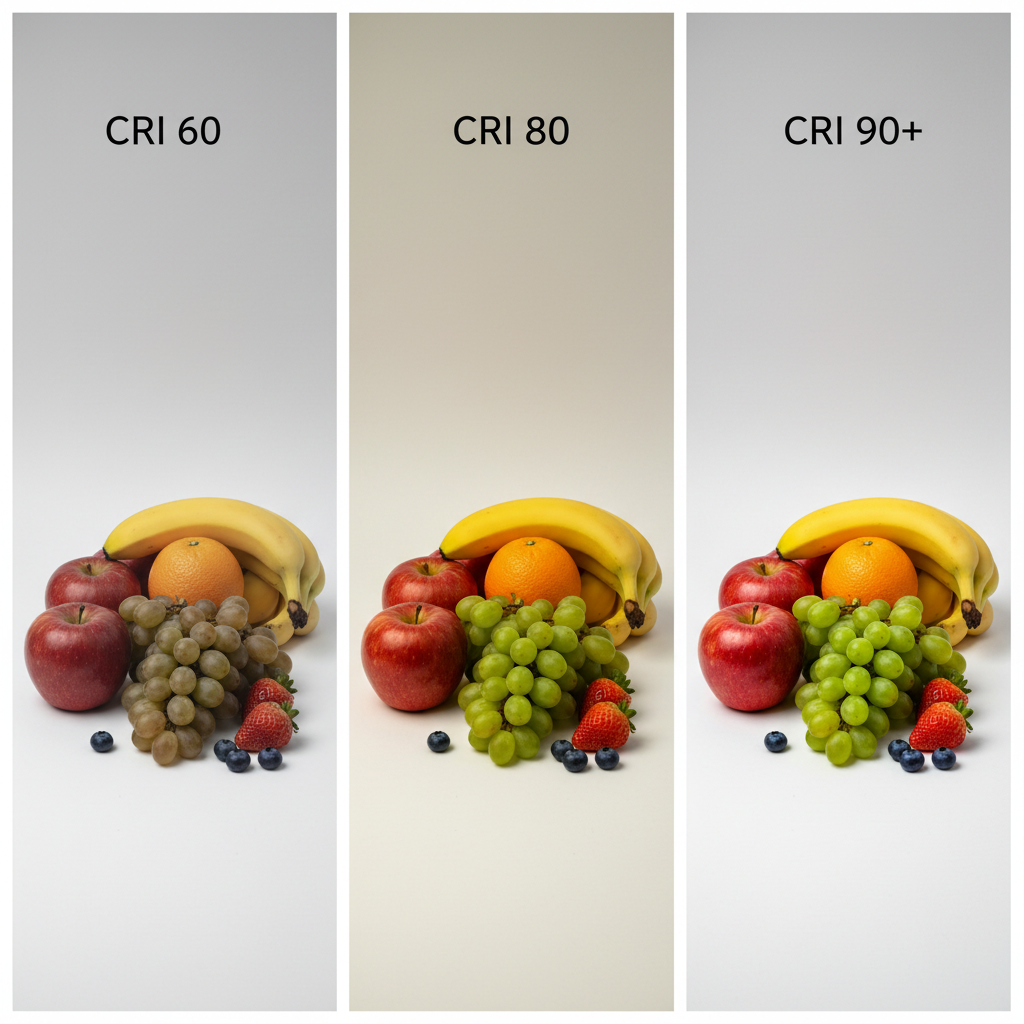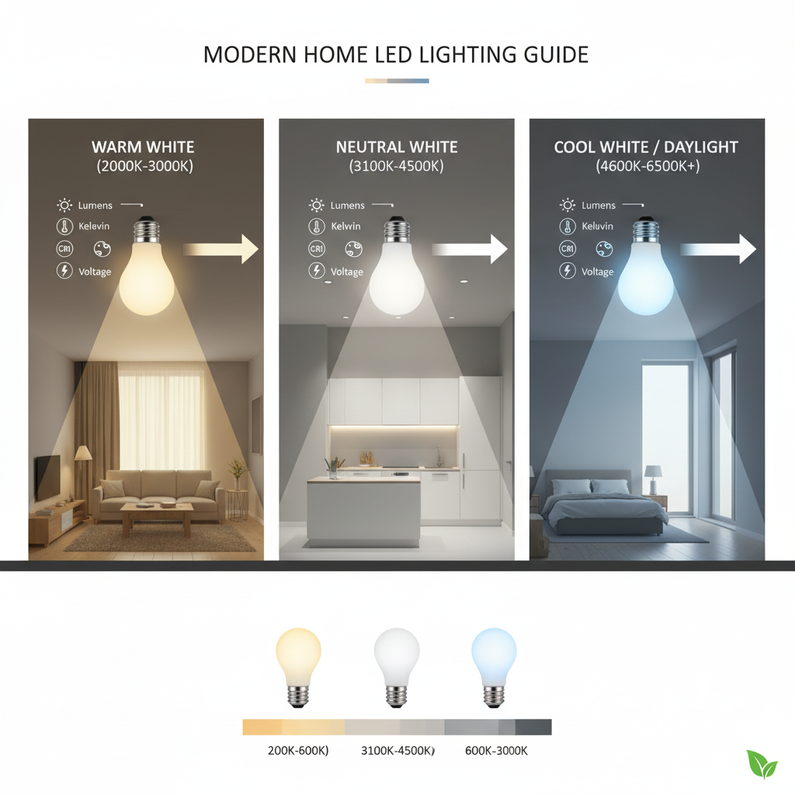Understanding LED Lighting: A Guide to Lumens, Kelvin & CRI
A Beginner's Guide to Understanding LED Lighting
Shopping for a new light can feel surprisingly complex. The packaging is often covered in terms like lumens, Kelvin, and CRI, leaving you to wonder what any of it means. It’s easy to just grab one that looks right and hope for the best. But what if you could understand those terms and choose the perfect light for any room with confidence?
This guide is designed to do just that. We'll break down the technical language of LED lighting into simple, practical information. By the end, you'll be able to walk into any store and select the ideal lighting to make your home look and feel exactly how you want it.
Lumens, Not Watts: Measuring Brightness
For decades, we were taught to measure a light bulb's brightness by its wattage. A 100-watt bulb was for a big room, and a 40-watt bulb was for a small lamp. However, wattage actually measures energy consumption, not brightness. With the arrival of energy-efficient LEDs, this old habit is no longer helpful.
Today, the most important measurement for brightness is lumens (lm). Lumens directly measure the total amount of visible light produced by a bulb. The more lumens, the brighter the light.
Think of it this way:
- Watts: The amount of energy a light uses.
- Lumens: The amount of light it produces.
Because LEDs are so efficient, they can produce the same number of lumens as an old incandescent bulb while using a fraction of the energy.
Here’s a simple conversion chart to help you transition from thinking in watts to lumens:
- To replace a 40W bulb, look for around 450 lumens.
- To replace a 60W bulb, look for around 800 lumens.
- To replace a 75W bulb, look for around 1100 lumens.
- To replace a 100W bulb, look for around 1600 lumens.
When you shop for a new light, ignore the watts and focus on the lumens to get the brightness you need.

Kelvin (K): Setting the Mood with Color Temperature
Have you ever noticed how some lights feel warm and cozy, like a candle, while others are cool and crisp, like a bright, sunny day? This quality is known as color temperature, and it’s measured in Kelvin (K). Despite the name "temperature," it has nothing to do with how hot the bulb gets.
Lower Kelvin values produce a warmer, more yellow or orange light, while higher values produce a cooler, bluer light.
Here’s a breakdown of common Kelvin ranges and where to use them:
- Warm White (2000K–3000K): This is the color of a traditional incandescent bulb. It creates a relaxing, inviting, and cozy atmosphere.
- Best for: Living rooms, bedrooms, dining rooms, and any space where you want to unwind.
- Neutral or Natural White (3100K–4500K): This light is more balanced, resembling clear daylight. It's friendly and bright without being harsh.
- Best for: Kitchens, bathrooms, basements, and home offices where you need clear visibility for tasks.
- Cool White / Daylight (4600K–6500K+): This range produces a very bright, crisp, blue-toned light similar to daylight on an overcast day. It promotes alertness and focus.
- Best for: Garages, workshops, security lighting, and task-specific areas like a craft table or makeup vanity where detail is important.
Choosing the right Kelvin temperature is one of the most effective ways to influence the mood of a room.
CRI: Seeing Colors as They Truly Are
The Color Rendering Index (CRI) is a scale from 0 to 100 that measures how accurately a light source reveals the true colors of objects compared to natural sunlight. Natural sunlight has a perfect CRI of 100.
Why does this matter? A low-CRI light can make colors appear dull, washed out, or even distorted. You might pick out a navy blue sock that looks black under your bedroom light, or your kitchen fruit bowl might appear less vibrant. For general home use, a CRI of 80 or higher is perfectly fine. You’ll find that food looks fresher, skin tones appear more natural, and your decor’s colors will be accurate.
However, for some areas, a higher CRI is better:
- A CRI of 90+ is recommended for kitchens (to see if food is fresh), bathrooms (for applying makeup), and art studios or workshops where color accuracy is critical.
High-quality LEDs often boast a CRI of 90 or more, ensuring your home looks exactly as you intended.

Voltage: Understanding Input and Output
Voltage is another term you might see, though it's less about choice and more about compatibility. It measures the pressure from an electrical circuit's power source.
Input Voltage
This is the voltage supplied to the light fixture from your home’s electrical system. In North America, the standard household voltage is 120V. Most lamps and light fixtures you buy are designed to work with this standard. Some larger appliances or specialized systems might use 240V. Always check that a fixture's input voltage matches your home's electrical supply.
Output Voltage
This refers to the voltage supplied from the fixture’s internal driver to the LED itself. Many LEDs operate on low-voltage DC (Direct Current), such as 12V or 24V. A component within the fixture called a driver converts the high-voltage AC (Alternating Current) from your wall outlet into the low-voltage DC the LED needs.
You generally don't need to worry about output voltage unless you are building a custom lighting setup or replacing a driver. For standard fixtures, just ensure the input voltage is compatible with your home.

Dimmability: Control Your Lighting Intensity
Not all LED bulbs are dimmable. If you try to dim a non-dimmable LED, it will likely flicker, hum, or fail completely. If you plan to use a fixture with a dimmer switch, you must buy a bulb that is specifically marked as "dimmable."
Furthermore, not all dimmer switches are compatible with LED bulbs. Older dimmers were designed for the high energy load of incandescent bulbs. Using one with a low-energy LED can cause performance issues. If you experience flickering with a dimmable LED, you may need to upgrade to a modern dimmer switch designed for LEDs, often called a CL, LED+, or ELV dimmer.
Conclusion: Shop for Lighting Like a Pro
Understanding the language of LED lighting empowers you to make smarter choices. You no longer have to guess which bulb is right. Instead, you can look at the specifications and know exactly how it will perform in your space.
Let’s recap the key takeaways:
- Lumens (lm): Judge brightness by lumens, not watts. More lumens mean a brighter light.
- Kelvin (K): Choose color temperature to set the mood. Lower Kelvin for warm, cozy light; higher Kelvin for cool, energizing light.
- CRI: Look for a CRI of 80+ for general use and 90+ for areas where color accuracy is essential.
- Voltage: Ensure the input voltage matches your home’s electrical system (usually 120V in the US).
- Dimmability: If using a dimmer switch, buy a bulb marked "dimmable" and consider upgrading your switch for best performance.
With this knowledge, you are now equipped to create a perfectly lit home that is beautiful, functional, and energy-efficient.
Recent Posts
-
Why Barn Style Post Lights Are the Perfect Blend of Style and Functionality
Outdoor lighting does more than just illuminate a path; it sets the mood, enhances security, and add …9th Dec 2025 -
Understanding LED Lighting: A Guide to Lumens, Kelvin & CRI
A Beginner's Guide to Understanding LED Lighting Shopping for a new light can feel surprisingly comp …31st Oct 2025 -
Barn Lights in Commercial Spaces: Adding Style to Restaurants and Cafes
The right lighting does more than just illuminate a space; it creates an experience. For restaurants …6th Oct 2025




